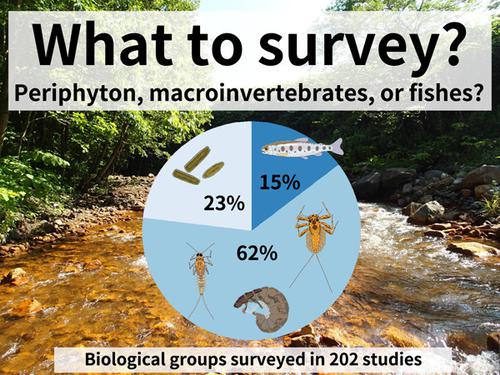当前位置:
X-MOL 学术
›
Environ. Toxicol. Chem.
›
论文详情
Our official English website, www.x-mol.net, welcomes your
feedback! (Note: you will need to create a separate account there.)
What to Survey? A Systematic Review of the Choice of Biological Groups in Assessing Ecological Impacts of Metals in Running Waters.
Environmental Toxicology and Chemistry ( IF 3.6 ) Pub Date : 2020-07-01 , DOI: 10.1002/etc.4810 Hiroki Namba 1, 2 , Yuichi Iwasaki 3 , Jani Heino 4 , Hiroyuki Matsuda 5
Environmental Toxicology and Chemistry ( IF 3.6 ) Pub Date : 2020-07-01 , DOI: 10.1002/etc.4810 Hiroki Namba 1, 2 , Yuichi Iwasaki 3 , Jani Heino 4 , Hiroyuki Matsuda 5
Affiliation

|
Which biological groups (in the present study, periphyton, macroinvertebrates, and fishes) are surveyed is a fundamental question in environmental impact assessment programs in metal‐contaminated rivers. We performed a systematic review of 202 studies that investigated the ecological impacts of metal contamination on aquatic populations and communities in streams and rivers to examine 1) which biological groups were surveyed, 2) whether their responses were correlated with each other, and 3) which biological group was most responsive to changes in metal contamination level. In these studies, published from 1991 to 2015, benthic macroinvertebrates were most frequently chosen throughout the period (59–76% in different 5‐yr periods), followed by periphyton and fishes, and the number of studies that surveyed at least 2 or 3 biological groups was very limited (10%). Pearson's correlation coefficients calculated between the metrics of different biological groups were often low, emphasizing the importance of investigating multiple biological groups to better understand the responses of aquatic communities to metal contamination in running waters. Despite the limited data collected, our meta‐analysis showed that, in most cases, biological metrics based on macroinvertebrates were more responsive to changes in metal contamination level than those based on periphyton or fishes. This finding suggests that benthic macroinvertebrates could be a reasonable choice to detect the ecological impacts of metal contamination on a local scale. Environ Toxicol Chem 2020;39:1964–1972. © 2020 The Authors. Environmental Toxicology and Chemistry published by Wiley Periodicals LLC on behalf of SETAC.
中文翻译:

要调查什么?在评估自来水中金属对生态的影响方面对生物族群选择的系统评价。
在金属污染的河流中,对哪些生物类别(在本研究中为浮游植物,大型无脊椎动物和鱼类)进行了调查,这是环境影响评估计划中的一个基本问题。我们对202项研究进行了系统的综述,这些研究调查了金属污染对河流和河流中水生种群和群落的生态影响,以检查1)被调查的生物组,2)它们的反应是否相互关联以及3)生物组对金属污染水平的变化最敏感。在1991年至2015年发表的这些研究中,整个时期内底栖大无脊椎动物的选择最为频繁(在5年内为59-76%),其次是浮游植物和鱼类,至少调查了2个或3个生物学组的研究数量非常有限(10%)。在不同生物组的指标之间计算出的皮尔逊相关系数通常很低,强调了研究多个生物组以更好地了解水生生物对流水中金属污染的响应的重要性。尽管收集的数据有限,但我们的荟萃分析显示,在大多数情况下,基于大型无脊椎动物的生物学指标比基于周生植物或鱼类的生物学指标对金属污染水平的变化更敏感。这一发现表明,底栖大型无脊椎动物可能是在局部规模上检测金属污染的生态影响的合理选择。在不同生物组的指标之间计算的相关系数通常很低,从而强调了调查多个生物组以更好地了解水生群落对流水中金属污染的响应的重要性。尽管收集的数据有限,但我们的荟萃分析显示,在大多数情况下,基于大型无脊椎动物的生物学指标比基于周生植物或鱼类的生物学指标对金属污染水平的变化更敏感。这一发现表明,底栖大型无脊椎动物可能是在局部规模上检测金属污染的生态影响的合理选择。在不同生物组的指标之间计算的相关系数通常很低,从而强调了调查多个生物组以更好地了解水生群落对流水中金属污染的响应的重要性。尽管收集的数据有限,但我们的荟萃分析显示,在大多数情况下,基于大型无脊椎动物的生物学指标比基于周生植物或鱼类的生物学指标对金属污染水平的变化更敏感。这一发现表明,底栖大型无脊椎动物可能是在局部规模上检测金属污染的生态影响的合理选择。强调了调查多个生物团体以更好地了解水生社区对自来水中金属污染的反应的重要性。尽管收集的数据有限,但我们的荟萃分析显示,在大多数情况下,基于大型无脊椎动物的生物学指标比基于周生植物或鱼类的生物学指标对金属污染水平的变化更敏感。这一发现表明,底栖大型无脊椎动物可能是在局部规模上检测金属污染的生态影响的合理选择。强调了调查多个生物团体以更好地了解水生社区对自来水中金属污染的反应的重要性。尽管收集的数据有限,但我们的荟萃分析显示,在大多数情况下,基于大无脊椎动物的生物指标比基于周生植物或鱼类的生物指标对金属污染水平的变化更敏感。这一发现表明,底栖大型无脊椎动物可能是在局部规模上检测金属污染的生态影响的合理选择。环境毒性化学2020; 39:1964–1972。©2020作者。Wiley Periodicals LLC代表SETAC发布的《环境毒理学和化学》。
更新日期:2020-07-01
中文翻译:

要调查什么?在评估自来水中金属对生态的影响方面对生物族群选择的系统评价。
在金属污染的河流中,对哪些生物类别(在本研究中为浮游植物,大型无脊椎动物和鱼类)进行了调查,这是环境影响评估计划中的一个基本问题。我们对202项研究进行了系统的综述,这些研究调查了金属污染对河流和河流中水生种群和群落的生态影响,以检查1)被调查的生物组,2)它们的反应是否相互关联以及3)生物组对金属污染水平的变化最敏感。在1991年至2015年发表的这些研究中,整个时期内底栖大无脊椎动物的选择最为频繁(在5年内为59-76%),其次是浮游植物和鱼类,至少调查了2个或3个生物学组的研究数量非常有限(10%)。在不同生物组的指标之间计算出的皮尔逊相关系数通常很低,强调了研究多个生物组以更好地了解水生生物对流水中金属污染的响应的重要性。尽管收集的数据有限,但我们的荟萃分析显示,在大多数情况下,基于大型无脊椎动物的生物学指标比基于周生植物或鱼类的生物学指标对金属污染水平的变化更敏感。这一发现表明,底栖大型无脊椎动物可能是在局部规模上检测金属污染的生态影响的合理选择。在不同生物组的指标之间计算的相关系数通常很低,从而强调了调查多个生物组以更好地了解水生群落对流水中金属污染的响应的重要性。尽管收集的数据有限,但我们的荟萃分析显示,在大多数情况下,基于大型无脊椎动物的生物学指标比基于周生植物或鱼类的生物学指标对金属污染水平的变化更敏感。这一发现表明,底栖大型无脊椎动物可能是在局部规模上检测金属污染的生态影响的合理选择。在不同生物组的指标之间计算的相关系数通常很低,从而强调了调查多个生物组以更好地了解水生群落对流水中金属污染的响应的重要性。尽管收集的数据有限,但我们的荟萃分析显示,在大多数情况下,基于大型无脊椎动物的生物学指标比基于周生植物或鱼类的生物学指标对金属污染水平的变化更敏感。这一发现表明,底栖大型无脊椎动物可能是在局部规模上检测金属污染的生态影响的合理选择。强调了调查多个生物团体以更好地了解水生社区对自来水中金属污染的反应的重要性。尽管收集的数据有限,但我们的荟萃分析显示,在大多数情况下,基于大型无脊椎动物的生物学指标比基于周生植物或鱼类的生物学指标对金属污染水平的变化更敏感。这一发现表明,底栖大型无脊椎动物可能是在局部规模上检测金属污染的生态影响的合理选择。强调了调查多个生物团体以更好地了解水生社区对自来水中金属污染的反应的重要性。尽管收集的数据有限,但我们的荟萃分析显示,在大多数情况下,基于大无脊椎动物的生物指标比基于周生植物或鱼类的生物指标对金属污染水平的变化更敏感。这一发现表明,底栖大型无脊椎动物可能是在局部规模上检测金属污染的生态影响的合理选择。环境毒性化学2020; 39:1964–1972。©2020作者。Wiley Periodicals LLC代表SETAC发布的《环境毒理学和化学》。











































 京公网安备 11010802027423号
京公网安备 11010802027423号